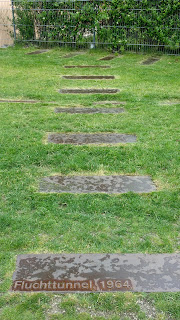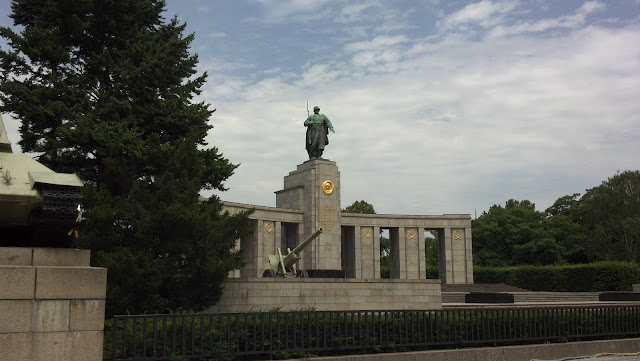Day 22 6/25/12

 Back in berlin, we started off our
day with a ride on the s-bahn followed by a walk to meet a man about a
building. En route, we passed the Olympic stadium from the 1936 Berlin
olypmics. Back to the building, it was one of the Unite de Habitation.
Buildings by this name were part of a modernist residential housing design
principle developed by Le Corbusier. The concept revolved around making the
building a sort of neighborhood. Each floor was designed with a long hallway
down the center called ‘streets’, and there was a market or grocery on the top
floor. The other unique attribute was the versatility and functionality of the
apartments. The apartment building was essentially constructed of a multitude
of cubes and the owner could buy as many blocks as he was able and tear down
walls and remodel and recombine any number of rooms to create a unique space.
Back in berlin, we started off our
day with a ride on the s-bahn followed by a walk to meet a man about a
building. En route, we passed the Olympic stadium from the 1936 Berlin
olypmics. Back to the building, it was one of the Unite de Habitation.
Buildings by this name were part of a modernist residential housing design
principle developed by Le Corbusier. The concept revolved around making the
building a sort of neighborhood. Each floor was designed with a long hallway
down the center called ‘streets’, and there was a market or grocery on the top
floor. The other unique attribute was the versatility and functionality of the
apartments. The apartment building was essentially constructed of a multitude
of cubes and the owner could buy as many blocks as he was able and tear down
walls and remodel and recombine any number of rooms to create a unique space.
We then walked around the
Hansaviertel interbau, a quarter of Berlin that was rebuilt by the West and
which became a center of prosperity and featured some interesting modern
architecture; pictured here is the St. Laurentius Kirche.
Day 23 6/26/12

The first stop of the day was at the
Dutch Embassy located overlooking the Spree. It is an architecturally
interesting building that defies the rigid building guidelines of the city
while still adhering to their requirements. A spiraling walkway, often with
glass floors, loops around the entire building. This walkway combined with the
architect’s plan to have every department open and looking into another
department was designed to show the openness of the Netherlands. A final
element to note is the ‘diagonal void’ through the building, added so that the
TV tower, a symbol of Berlin, could always be seen from the park by the Spree.
That afternoon we passed by the Red Rauhous on our way to the Karl-Marx-Allee, the socialist urban planning response to the West’s Hansaviertel. In a way the area symbolized the socialist regime, with elegant facades masking poor quality buildings. We continued on to Treptower Park, the location of the giant Soviet memorial.

The statue of the soviat soldier dominated the landscape, holding a child in one arm, a sword in the other and crushing a swastika beneath his boot
Day 24 6/27/12
Today we did Checkpoint Charlie. The
museum focused mostly on the oppression of the GDR, the Berlin wall, and the
bids for freedom made by the East German people. While an interesting place, it
was also one of the most tourist-packed places we went in Berlin.

 However, about
halfway through the museum there is a small double staircase that for some
reason most people do not perceive. It contains a good half of the museum, and,
going up it I was happy to find some breathing room. This section of the museum
contained a Ronald Reagan room (where I watched the entirety of his speech at
the Berlin Wall) and rooms documenting the modern Berlin situation up to the
last few years. Also in this ‘secret’ section of the museum were the original Checkpoint
Charlie sign and a segment of concrete where one of the first white lines was
painted indicating where the Berlin Wall would later stand.
However, about
halfway through the museum there is a small double staircase that for some
reason most people do not perceive. It contains a good half of the museum, and,
going up it I was happy to find some breathing room. This section of the museum
contained a Ronald Reagan room (where I watched the entirety of his speech at
the Berlin Wall) and rooms documenting the modern Berlin situation up to the
last few years. Also in this ‘secret’ section of the museum were the original Checkpoint
Charlie sign and a segment of concrete where one of the first white lines was
painted indicating where the Berlin Wall would later stand.
That afternoon we walked to the
nearby Berlin Wall Memorial & Documentation Center. This area retains a
well-preserved area of the East-West boundary as well as stone paths marking
where those famous escape tunnels lied underground.


Today we met briefly to look at the
smaller Soviet monument located in the Tiergarten; this monument, while
smaller, was built immediately after the Soviets seized Berlin at the end of
the war and used stones torn from Hitler’s Chancellery.
After that, we were dismissed to
wander the city on our last day in Berlin.

















































